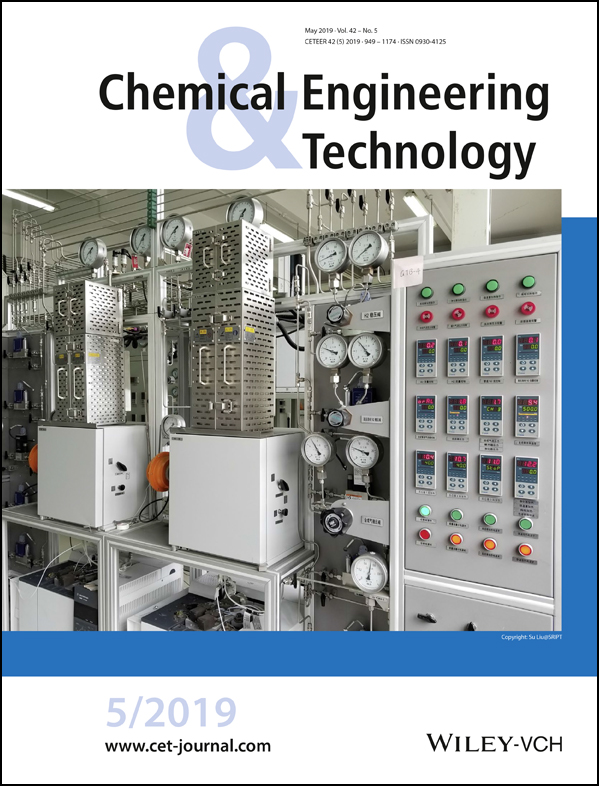Mixing and Heat Transfer of Granular Materials in an Externally Heated Rotary Kiln
Zhe Zhang
Central South University, College of Mechanical and Electrical Engineering, 410083 Changsha, China
Search for more papers by this authorCorresponding Author
Yilun Liu
Central South University, College of Mechanical and Electrical Engineering, 410083 Changsha, China
Correspondence: Yilun Liu ([email protected]), Central South University, College of Mechanical and Electrical Engineering, Changsha 410083, China.Search for more papers by this authorXianqiong Zhao
Central South University, College of Mechanical and Electrical Engineering, 410083 Changsha, China
Search for more papers by this authorYougang Xiao
Central South University, College of Traffic and Transportation Engineering, 410083 Changsha, China
Search for more papers by this authorXianming Lei
Shaoyang University, College of Mechanical and Energy Engineering, 422004 Shaoyang, China
Search for more papers by this authorZhe Zhang
Central South University, College of Mechanical and Electrical Engineering, 410083 Changsha, China
Search for more papers by this authorCorresponding Author
Yilun Liu
Central South University, College of Mechanical and Electrical Engineering, 410083 Changsha, China
Correspondence: Yilun Liu ([email protected]), Central South University, College of Mechanical and Electrical Engineering, Changsha 410083, China.Search for more papers by this authorXianqiong Zhao
Central South University, College of Mechanical and Electrical Engineering, 410083 Changsha, China
Search for more papers by this authorYougang Xiao
Central South University, College of Traffic and Transportation Engineering, 410083 Changsha, China
Search for more papers by this authorXianming Lei
Shaoyang University, College of Mechanical and Energy Engineering, 422004 Shaoyang, China
Search for more papers by this authorAbstract
A heat transfer model based on the discrete element software EDEM and the secondary development tool C++ is developed to simulate the mixing and heat transfer process of particles under different parameters. This model is validated by comparison with experimental data and proved reasonable. It aims to study the heat transfer law of flowing particles in an externally heated rotary kiln and reveal the correlation between mixing and heat transfer from the mechanism. The results show that the combination of the total contact area between adherent particles and the drum wall, the mean temperature difference between adherent particles and the drum wall, the total contact area between particles, and the mean temperature difference between particles affect the heat transfer process. Changes in the temperature differences caused by the mixing rate dominate the heat transfer at different speeds or filling rates.
References
- 1 J. Wu, X. Y. Li, B. M. Chen, Trans. Chin. Soc. Agric. Eng. 2014, 30 (13), 256–262. DOI: https://doi.org/10.3969/j.issn.1002-6819.2014.13.031
- 2 L. P. Zhu, X. Qin, Z. L. Yuan, J. Southeast Univ., Nat. Sci. Ed. 2014, 44 (4), 756–763. DOI: https://doi.org/10.3969/j.issn.1002-0505.2014.04.014
- 3 F. Herz, I. Mitov, E. Specht, Chem. Eng. Sci. 2012, 82, 312–318. DOI: https://doi.org/10.1016/j.ces.2012.07.042
- 4 J. Mellmann, Powder Technol. 2001, 118 (3), 251–270. DOI: https://doi.org/10.1016/S0032-5910(00)00402-2
- 5 A. Ingram, J. P. K. Seville, D. J. Parker, Powder Technol. 2005, 158 (1–3), 76–91. DOI: https://doi.org/10.1016/j.powtec.2005.04.030
- 6 A. A. Boateng, P. V. Barr, J. Fluid Mech. 1997, 330, 233–249. DOI: https://doi.org/10.1017/S0022112096003680
- 7 H. Liu, H. C. Yin, M. Zhang, Powder Technol. 2016, 287, 239–247. DOI: https://doi.org/10.1016/j.powtec.2015.10.007
- 8 A. A. Aissa, C. Duchesne, D. Rodrigue, Chem. Eng. Sci. 2010, 65 (2), 786–795. DOI: https://doi.org/10.1016/j.ces.2009.09.031
- 9 A. I. Nafsun, F. Herz, E. Specht, Exp. Heat Transfer 2016, 29 (4), 520–535. DOI: https://doi.org/10.1080/08916152.2015.1036180
- 10 A. I. Nafsun, F. Herz, Appl. Therm. Eng. 2016, 103, 1039–1047. DOI: https://doi.org/10.1016/j.applthermaleng.2016.04.128
- 11 R. Dennis, P. Van, Chem. Eng. Sci. 2006, 61 (13), 4462–4465. DOI: https://doi.org/10.1016/j.ces.2006.02.013
- 12 G. J. Finnie, N. P. Kruyt, M. Ye, Chem. Eng. Sci. 2005, 60 (15), 4083–4091. DOI: https://doi.org/10.1016/j.ces.2004.12.048
- 13 P. Thammavong, M. Debacq, S. Vitu, Chem. Eng. Technol. 2011, 34 (5), 707–717. DOI: https://doi.org/10.1002/ceat.201000391
- 14 A. A. Boateng, P. V. Barr, Int. J. Heat Mass Transfer 1996, 39 (10), 2131–2147. DOI: https://doi.org/10.1016/0017-9310(95)00272-3
- 15 S. Deliang, L. Watson, J. J. Vargas, Chem. Eng. Technol. 2008, 63 (18), 4506–4516. DOI: https://doi.org/10.1016/j.ces.2008.06.006
- 16 B. Yohannes, H. Emady, K. Anderson, Phys. Rev. E 2016, 96 (4), 042902. DOI: https://doi.org/10.1103/PhysRevE.94.042902
- 17 H. Chen, Y. G. Xiao, Y. L. Liu, Powder Technol. 2017, 318, 507–517. DOI: https://doi.org/10.1016/j.powtec.2017.05.047
- 18 X. Y. Liu, Z. Hu, W. N. Wu, Powder Technol. 2017, 315, 438–444. DOI: https://doi.org/10.1016/j.powtec.2017.04.036
- 19 P. Y. Liu, R. Y. Yang, A. B. Yu, Chem. Eng. Sci. 2013, 86, 99–107. DOI: https://doi.org/10.1016/j.ces.2012.06.015
- 20 B. Chaudhuri, F. J. Muzzio, M. S. Tomassone, Chem. Eng. Sci. 2006, 61 (19), 6348–6360. DOI: https://doi.org/10.1016/j.ces.2006.05.034
- 21 H. T. Nguyen, B. Cosson, M. F. Lacrampe, Int. J. Mater. Form. 2015, 8 (3), 423–438. DOI: https://doi.org/10.1007/s12289-014-1185-8
- 22 H. N. Emady, K. V. Anderson, W. G. Borghard, Chem. Eng. Technol. 2016, 152, 45–54. DOI: https://doi.org/10.1016/j.ces.2016.05.022
- 23 I. Figueroa, W. L. Vargas, J. J. McCarthy, Chem. Eng. Technol. 2010, 65 (2), 1045–1054. DOI: https://doi.org/10.1016/j.ces.2009.09.058
- 24 Q. Xie, Z. B. Chen, Q. F. Hou, Powder Technol. 2017, 314, 175–181. DOI: https://doi.org/10.1016/j.powtec.2016.09.022
- 25 M. A. I. Schutyser, J. T. Padding, F. J. Weber, Biotechnol. Bioeng. 2001, 75 (6), 665–675. DOI: https://doi.org/10.1002/bit.1192
- 26 D. R. V. Puyvelde, B. R. Young, M. A. Wilson, Powder Technol. 1999, 106 (3), 183–191. DOI: https://doi.org/10.1016/S0032-5910(99)00074-1
- 27 H. Chen, X. Q. Zhao, X. Q. Zhao, Trans. Nonferrous Met. Soc. China 2016, 26, 527–535. DOI: https://doi.org/10.1016/S1003-6326(16)64110-9
- 28 Q. C. Sun, G. Q. Wang, Introduction to the Mechanics of Particulate Matter, 1rd ed., Science Press, Beijing 2009.
- 29 B. Chaudhuri, F. J. Muzzio, M. S. Tomassone, Powder Technol. 2010, 198 (1), 6–15. DOI: https://doi.org/10.1016/j.powtec.2009.09.024




